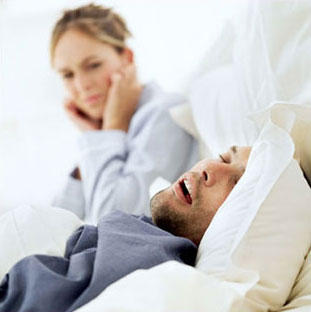
How common is snoring in society ?
Snoring is common after a heavy meal, especially if you take alcohol and sleep, but some people snore routinely every night. It is known that approximately one-third of men and one-fifth of women snore habitually in this way.
Why do we snore ?
The maxillofacial skeletal system and soft palate muscles exert a counterforce against the 'vacuum force' created by the air passing through our mouth and nose while we are awake. However, while we are resting during sleep, our muscles are relaxed, including soft palate muscles. Anatomical problems such as nasal septum deviation, enlarged turbinates, enlarged adenoids or tonsils, sagging of soft palate, elongated uvula, and facial-jaw bones abnormalities can lead to snoring via vibration of soft tissues during the sleep. Snoring is also more common among overweight people.
What does apnea mean ?
Apnea means the cessation of breathing at the level of the mouth and nose for at least 10 seconds during sleep.
What does hypopnea mean ?
Hypopnea is at least 50% reduction in airflow at the level of the mouth and nose for at least 10 seconds during sleep.
What does desaturation mean ?
Desaturation is the reduction of oxygen level in the blood.
How many types of apnea are there ?
There are three types of apnea, namely obstructive, central, and mixed apnea.
In which apnea treatment does ENT play a role ?
ENT has a role in the treatment of obstructive sleep apnea syndrome (OSAS)
How often is OSAS encountered ?
It is thought that OSAS is seen in approximately in 4% of the population. However, while this rate decreases to 2% in the female population, it rises to 5-10% in the male population.
What is the cause of OSAS ?
When the obstruction related to the factors mentioned above as causes of snoring at the level of the nose, nasopharynx, soft palate, and base of the tongue is severe, OSAS can occur. OSAS might also be encountered in patients with vocal cord paralysis or laryngeal/ hypopharyngeal masses. Snoring is rather a social problem, however apnea is a serious health problem that needs to be treated.

What are the symptoms of OSAS ?
The patients with OSAS feel generally tired when they wake up. Daytime sleepiness and poor concentration are also common. It is estimated that OSAS is responsible for a certain percentage of traffic accidents.
Which diseases are associated with OSAS ?
The risk of myocardial infarction, stroke, arrhythmia and hypertension increases with OSAS.
How is the diagnosis of OSAS made ?
Witness of apnea is very precious. In patients with suspected apnea, the definitive diagnosis is made with a sleep test called polysomnography.
How is the sleep test done ?
Classically, the sleep test is performed in sleep laboratories by keeping the patient asleep for one night. During sleep, the patient is connected to some devices and parameters such as apnea-hypopnea index (AHI), desaturation in the blood, and jaw and leg muscle movements are measured. Nowadays, home-type polysomnography devices are also available.
What is severe OSAS ?
-If the AHI is between 5-15, the OSAS is mild; if it is between 15-30, moderate; and if AHI is above 30, the OSAS is severe.
Is there any difference between pediatric patients and adults concerning the apnea ?
The most common cause of apnea in children is enlargement of the tonsils and adenoids. Again, unlike an adult, a child is considered to have OSAS even if the apnea index is one. The sleep test is not routinely used in children as it is in adults. Witnessed apnea is considered sufficient for diagnosis.
What are treatment options for OSAS ?
In the treatment of OSAS, surgical methods, compressed air masks and oral appliances are used.
Which techniques are used in snoring-apnea surgery ?
A wide variety of surgical methods have been described in snoring-apnea surgery, depending on the underlying anatomical cause. If there is a nasal obstruction related to a convexity in the nose, other nasal defornities, this is corrected with septum deviation surgery, or septorhinoplasty. If the turbinates are enlarged, they can be reduced by radiofrequency method or by partial surgical removal. If we deal with polyps and sinusitis, this can be resolved with endoscopic sinus surgery. Especially in adenotonsillar hypertrophy, which is the most important cause of pediatric apnea, patients benefit greatly from adenotonsillectomy. Many surgeries have been described for the tonsils, soft palate, uvula, and base of the tongue in adults. Apart from this, very high successes have been reported in maxilla-mandibular advancement surgeries. If there is a problem such as vocal cord paralysis or tracheal stenosis, surgeries can be performed accordingly. The most extreme example of surgical treatment is tracheotomy, which is creation of a hole on the anterior wall of the trachea. This is performed especially in morbidly obese patients, when other methods cannot be applied or fail, and if the problem has become a life-threatening condition.
What is compressed air mask (PAP- positive airway pressure) therapy ?
In this treatment, apnea is prevented by giving the patient compressed air through the nose or nose and mouth with a mask, keeping the airway constantly open.
What is the difficulty of PAP therapy ?
Actually, this treatment is very effective. However, a lot of patients deny this method.
How does the oral appliances work ?
The main function of these devices is to pull the lower jaw and base of the tongue anteriorly, and to increase the posterior airway space which possibly prevent or decerease the apneas.
What is the success rate of surgical methods ?
While the short term success rates of surgical methods concerning the soft palate and base of the tongue have been demonstrated to be high, it is found that this success may severely drop down in 5-year follow-ups.
What are the complications of surgical methods ?
Complications of nose surgery has been already mentioned in the related chapters. Complication concerning soft palate and base of the tongue surgery include severe pain, bleeding, infection, velopharyngeal insufficiency, haematoma, and impaired movement ot the tongue.
Are soft palate and baseof the tonge surgeries painful ?
Nose surgeries are not much painful, yet on the contrary, patients may experience severe pain following soft palate and base of the tongue surgeries.
How is the postoperative cours following soft palate and base of the tongue surgeries ?
The most important point is pain control. Soft diet is administered. With the relief of pain, the patient gradually returns to normal.
Is AHI important in the treatment decision ?
AHI, together with the examination findings, is of great importance in the treatment decision. Although the patient may benefit from soft palate and base of the tongue surgeries in mild or moderate apnea, the preferred treatment in cases with severe apnea is PAP using mask. However, if there is an anatomical problem such as nasal septum deviastion, turbinate hypertrophy, or nasal polyp, which will possibly increase the pressure level in PAP treatment, nasal obstruction is first solved with surgery.
What is your approach to apnea ?
Snoring-apnea problems are complex in which many factors play a role. Therefore customised approach is important. I try first to determine the anatomical factors contributing to airway collapse. I advise some life style changes according to patient’s needs such as losing weight, quitting smoking, reducing alcohol consumption, making exercise, etc. As surgical approach, I first fix nasal obstruction if there is any, and afterwards, I refer the patient to a sleep laboratory for a sleep test. If he or she has severe OSAS, I advise PAP use, and if the patient cannot tolerate PAP, I explain the possible benefit of a second surgery. When we deal with mild or moderate OSAS, I try to explain the advantages and disadvantages of both PAP treatment and surgery, and ask the patient to choose in between.


